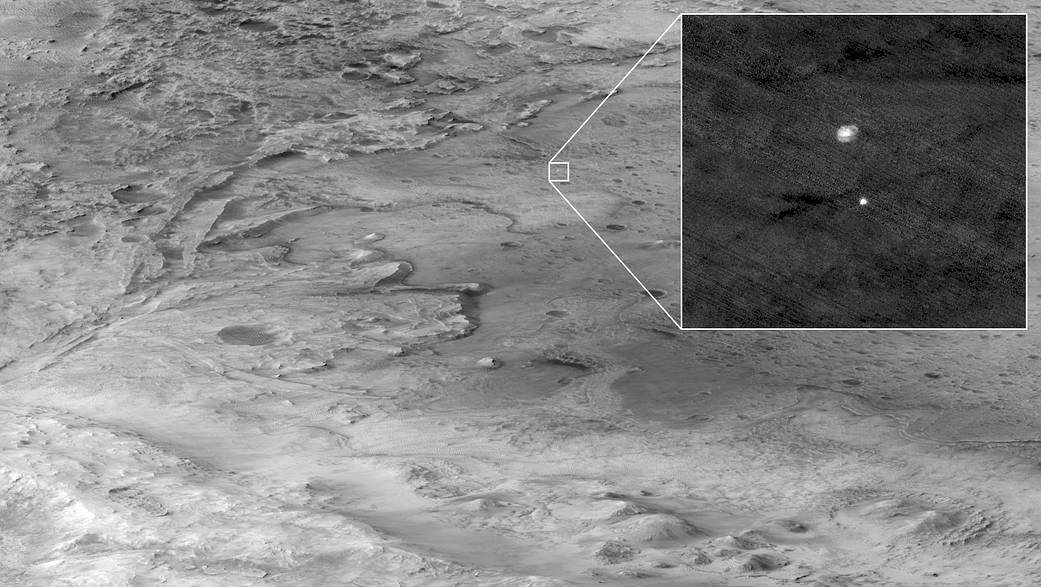Test. Test again. Test again.
Testing spacecraft components prior to flight is vital for a successful mission.
Rarely do you get a do-over with a spacecraft after it launches especially those bound for another planet. You need to do everything possible to get it right the first time.
Three successful sounding rocket missions from NASA’s Wallops Flight Facility in Virginia in 2017 and 2018 to test a supersonic parachute proved their worth with the successful landing of the Perseverance mission on the red plant.
After a 203-day journey traversing 293 million miles, the supersonic parachutes, designed to slow the rover’s descent to the planet’s surface, successfully deployed and inflated leading to the smooth touchdown of Perseverance.
Perseverance Landing: Video from Mars
“This mission required us to design and build a 72-ft parachute that could survive inflating in a Mach 2 wind in about half a second. This is an extraordinary engineering challenge, but one that was absolutely necessary for the mission,” said Ian Clark, the test’s technical lead from NASA’s Jet Propulsion Laboratory in Southern California. “To ensure they worked at Mars under those harsh conditions, we had to test our parachute designs here at Earth first. Replicating the Martian environment meant that we needed to get our payload half way to the edge of space and going twice the speed of sound. Sounding rockets were critical to our testing and ultimately our landing on Mars.”
The NASA team tested the parachute three times in Mars-relevant conditions, using Black Brant IX sounding rockets. The final test flight exposed the chute to a 67,000-pound (300,000- Newton) load — the highest ever survived by a supersonic parachute and about 85% higher than what the mission’s chute was expected to encounter during deployment in Mars’ atmosphere.
Testing a Parachute for Mars video
“When the spacecraft successfully touched down last week it was a great feeling of accomplishment for the parachute testing team,” said Giovanni Rosanova, chief of the NASA Sounding Rockets Program Office at Wallops. “Placing the test component in the right conditions with a sounding rocket was challenging and the importance of the tests to the success of the Mars landing was an exciting motivating factor for the team. We are proud to have been a part of this mission.”
Suborbital vehicles – sounding rockets, scientific balloons, and aircraft – are great platforms for developing and testing spacecraft instruments and components. Spacecraft including Terra, Aqua, COBE, CGRO, SPITZER, SWIFT, HST, SOHO, and STEREO, have heritage connected with suborbital vehicle missions.
Rosanova said, “One of the beauties of suborbital vehicles is that an instrument or its components can be flown, improved, and then re-flown. This can be done within a few years, providing the opportunity for scientists to work out the bugs before flying on a spacecraft.”
In the case of the Mars 2020 parachutes, the first flight was a test to see if the right conditions can be achieved during the flight to simulate what the parachutes will encounter descending through the Mars’ atmosphere. The second flight, 6 months later in March 2018, was the first full test of the parachute. The final successful test conducted in September 2018 provided the results needed for the Perseverance parachute team to be confident that the design was ready for the Mars 2020 mission.
NASA is currently developing plans for a Mars Sample Return mission to retrieve the rocks and soil samples collected by Perseverance and return them to Earth. Teams are preparing to test concepts for the Mars Ascent Vehicle that will carry the collected samples from the planet’s surface.
Suborbital vehicles, either a sounding rocket or a scientific balloon, are being examined for testing the ascent vehicle. Wallops personnel are excited to be a part of this next step of exploring the red planet as we go the Moon, Mars, and beyond.
Header Image: The descent stage holding NASA’s Perseverance rover can be seen falling through the Martian atmosphere, its parachute trailing behind, in this image taken on Feb. 18, 2021, by the High Resolution Imaging Experiment (HiRISE) camera aboard the Mars Reconnaissance Orbiter. Credit NASA/JPL Cal-Tech
Keith Koehler
NASA’s Wallops Flight Facility





























